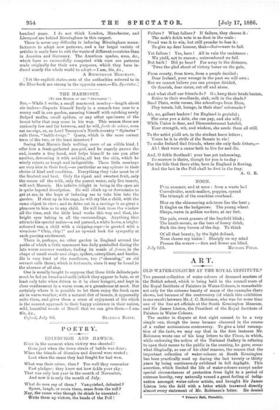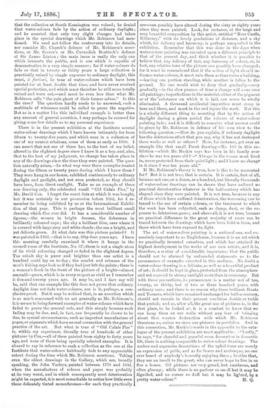ART.
OLD WATER-COLOURS AT THE ROYAL INSTITUTE
THE present collection of water-colours of deceased masters of the British school, which is being held in the council-room of the Royal Institute of Painters in Water-Colours, is remarkable not only for the extreme beauty of many of the examples there shown, but because of the controversy (of which this exhibition is one result) between Mr. J. C. Robinson, who was for some time
of the fine art officials at the South Kensington Museum, and Sir James Linton, the President of the Royal Institute of Painters in Water. Colours.
The matter in dispute at first sight seemed to be a very simple one, though the issue became obscured in the course of a rather acrimonious controversy. To give a brief resump- tion of the facts, we may say that in the first instance Mr. Robinson wrote one of his long letters to the Times, in which, while endorsing the action of the National Gallery in refusing to open their rooms to the public in the evening, he gave, some- what illogically, as one of his chief reasons, the reason that the important collection of water-colours at South Kensington has been practically used up daring the last twenty or thirty years by being continuously exhibited in full daylight. This assertion, which limited the life of water-colours except under special circumstances of protection from light to a period of extreme brevity, very naturally roused a great feeling of indig- nation amongst water-colour artists, and brought Sir James Linton into the field with a letter which traversed directly almost every statement of Mr. Robinson's letter. He denied
• Prinoe'm MR, Piccadilly.
that the collection at South Kensington was ruined; he denied that water-colours fade by the action of ordinary daylight ; and he asserted that only very slight changes had taken place in the special drawings which Mr. Robinson had men- tioned. We need not follow the controversy into its details, nor consider Mr. Church's defence of Mr. Robinson's asser- tions, or Mr. Severn's or Mr. Cavendish Bentinck's defence of Sir James Linton ; the main issue is really the only one which interests the public, and is one which is capable •of demonstration in a very simple manner; for if water-colours do fade so that in twenty or thirty years a large collection is practically ruined by simple exposure to ordinary daylight, this must, a, fortiori, be true of water-colours which have been painted for at least double that time, and have never received special protection, and which must therefore be still more totally ruined and worn out,—and must be even less than what Mr. Robinson calls "the pale ghost of their former selves." Is this the case ? The question hardly needs to be answered, such a multitude of witnesses could be called to prove the negative. But as in a matter 1-ke this individual example is better than any amount of general assertion, I may perhaps be excused for giving some few details as to my personal experience.
There is in the present exhibition at the Institute several water-colour drawings which I have known intimately for from fifteen to twenty-five years, and which were in a collection of one of my nearest relations, some of them as early as 1860. I -can assert that not one of these has, to the best of my belief, altered in the slightest degree since I knew it as a boy, and, also, that to the best of my judgment, no change has taken place in any of the drawings since the time they were painted. The ques- tion naturally arises,—In what way were these examples treated during the fifteen or twenty years during which I knew them? They were hung in our house, exhibited continuously to ordinary daylight and gaslight, and not even protected, as they should have been, from direct sunlight. Take as an example of these -one drawing only, the celebrated small "Old Calais Pier," by Mr. David Cox. I forget the exact date at which it was bought, but it was certainly in our possession before 1862, for I re- member its being exhibited by us at the International Exhibi- tion of that year. This is perhaps the most brilliant small drawing which Cox ever did. It has a considerable number of figares,—the women in bright dresses, the fishermen in brilliantly coloured caps ; the sky a brilliant blue, save where it is covered with large grey and white clouds ; the sea a bright, and yet delicate green. At what date was this picture painted ? It was painted in 1832,—that is to say, fifty-four years ago. I have this morning carefully examined it where it hangs in the council room of the Institute, No. 67; there is not a single atom of its vivid colouring changed or faded in the slightest degree. The cobalt sky is purer and brighter than one artist in a hundred could lay on to-day ; the scarlet and crimson of the men's fishing-caps look as if they had just left the palate ; there is a woman's frock in the front of the picture of a bright—almost emerald—green, which is in every respect as vivid as I remember it five-and-twenty years ago. It may be, and I dare say will be, said that one example like this does not prove that ordinary -daylight does not fade water-colours, nor is it, perhaps, a con- clusive proof. But it may be noticed that, in an assertion which is as much concerned with an art generally as Mr. Robinson's, it is no use to bring forward examples of water-colours which have faded to prove the general rule, and this simply because such fading may be due, and, in fact, can frequently be shown to be due, to special circumstances, such as imperfect manufacture of paper, or pigments which have no real connection with the general practice of the art. But what is true of "Old Calais Pier" is, within my experienCe, literally true of hundreds of other -pictures by Cox,—all of them painted from eighty to forty years
ago, and none of them being specially selected examples. It is absurd to say in reference to such a collection as the one at the
Institute that water-colours habitually fade to any appreciable
extent during the time which Mr. Robinson mentions. Taking even the oldest drawings in the Gallery, which are, broadly
speaking, the John Varleys, painted between 1778 and 1842, when the manufacture of colours and paper was probably at its very worst, and in which consequently most deterioration might be expected, it is most remarkable to notice how little even these delicately tinted monochromes—for such they practically
are—can possibly have altered during the sixty or eighty years since they were painted. Look, for instance, at the large and very beautiful composition by this artist, entitled "Ross Castle, Killarney," with its lovely gradations of distance, and a sky which, for delicacy and harmony, is perhaps unequalled in the exhibition. Remember that this was done in the days when water-colour painting was executed upon a different principle to that of the present day, and think whether it is possible to believe that any delicacy of tint, any harmony of colour, or, in fact, any relative tone of the picture can possibly have changed; for it must be remembered that if the action of light should in- fluence water-colours, it must ruin them as time ruins a building, —leaving one portion standing, while another is fallen to the ground. No one would wish to deny that gradually—very gradually —in the slow process of time a change will come over all paintings; imperfections in the material, either of the pigment or of the *substance on which it is laid, can never be wholly eliminated. A thousand accidental impurities must creep in here and there, and must in the end injure the work. Bat this is a wholly different thing to asserting that by the action of daylight daring a given period the colours of water-colour painting fade; and it is diffieult to conceive what answer could be given by Mr. Robinson in defence of his own view to the following question :—How do you explain, if ordinary daylight has the deleterious effect that you say, why it has not destroyed these works as well as others ? How, for instance, get over an example like that small Prout drawing—No. 16:3 in this exhibition—which Mr. Ruskin says has been in his family ever
since he was ten years old ?—" Always in the rooms most lived in, never protected from their quiet light ; and I know no change in it since I was ten years old."
If Mr. Robinson's theory is true, how is this to be accounted for ? But it is not true, that is certain. It is certain, first of all, because not one, or a dozen, or a hundred, but literally thousands of water-colour drawings can be shown that have suffered no practical deterioration whatever in the half-century which has elapsed since they were painted. It is not true, because in any of those which have suffered deterioration, the worsening can be traced to the use of certain colours, or the treatment to which the work has been subjected, such as damp, dust, or the ex- posure to deleterious gases; and above all, it is not true, because no practical difference in the great majority of cases can be traced between the drawings which have been hidden from, and those which have been exposed to, light.
The art of water-colour painting is a national one, and ex- cessively important to us Englishmen, because it is an art which we practically invented ourselves, and which has attained its highest development in the works of our own artists, and it is, therefore, a matter of considerable importance that the public should not be alarmed by unfounded statements as to the permanence of examples executed in this medium. No doubt a water-colour drawing is a delicate, as well as a beautiful product
of art ; it should be kept in glass, protected from the atmosphere and not exposed to strong sunlight more than is necessary. But with these precautions, its permanence is a matter not of ten, twenty, or thirty, but of two or three hundred years, with ordinary care ; and there is no reason why these brilliant Hunts and Turners, which have remained unchanged for half-a-century, should not remain in their present condition double or treble that period; and as, after all, the great use of pictures is, in the first place, to be looked at, it is a comfort to know that we can hang them on our walls without any fear of bringing about that wanton destruction with which Mr. Robinson threatens us, unless we store our pictures in portfolios. And in this connection, Mr. Ruskin's words in the appendix to the cata- logue of the present exhibition are most applicable :—"Lastly," he says, "for cheerful and graceful room decoration in domestic life, there is nothing comparable to water-colour drawings. The useless and expensive decorations of the upholsterer are merely an expression of pride, and as for fresco and arabesque, no one ever heard of anybody's honestly enjoying them ; besides that, they are an insult to the guest, who can never hope to live in so fine a house. Oil pictures are very grand, but cumbrous, and often gloomy ; while there is no parlour so small but it may be dignified, and no corner so dull but it may be lighted, by a



































 Previous page
Previous page